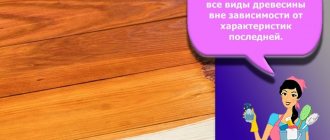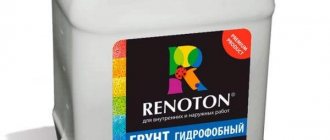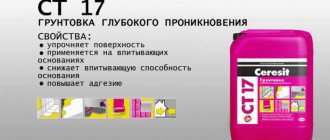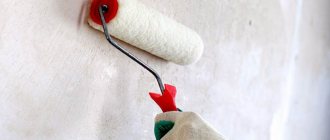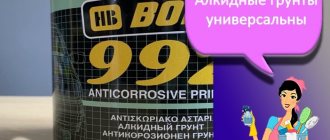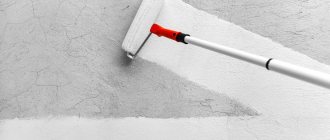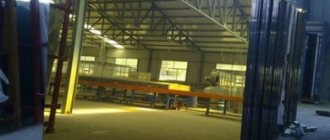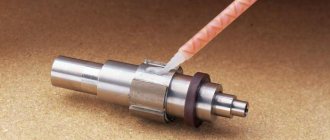Functions of deep penetration primer
When planning repair work, you need to clearly understand why each technological operation is being performed. Application of a deep penetration primer allows you to:
- strengthen the surface of bulk and porous materials;
- improve the adhesion of the base of the wall and ceiling with finishing materials;
- reduce the absorbency of building materials. This makes it possible:
- reduce the consumption of wallpaper or tile adhesive, paint;
- ensure uniform application, which means a higher quality finish;
- get a smoother surface.
- prevent the development of pathogenic microflora;
- bind the dust.
Functional purpose
As you know, concrete is a material with high density and hardness, but at the same time it contains micropores. The porous structure has both its advantages and disadvantages. In particular, if the concrete surface is left as is, then its pronounced absorbent ability leads to increased costs of paint and varnish products. A primer with a deep penetration effect is a special composition that gets into micropores. This allows you to strengthen the concrete from the inside, and at the same time increase its adhesive properties. As a rule, this is achieved through acrylic polymers, which are rich in some types of deep penetration primers for concrete. When using them, along with the strengthening effect, the absorbency of the building material decreases.
Primer mixtures are used for exterior or interior finishing. After surface treatment, other types of finishing can be used: putty; tiling; paint and varnish products; plaster (including decorative); wallpaper (including liquid). In this case, the primer makes it possible to apply subsequent finishing materials in an even layer. Based on this, it becomes clear that the application of such compounds is a necessary and important process.
Deep primer
A soil that can penetrate deep into the base of the treated surface has a specific composition, technical characteristics, pros and cons, and scope of application.
Peculiarities
The inclusion of finely dispersed latex (particles 30-60 nanometers in size) in the solution allows the primer to penetrate deeply into the composition of the material being processed due to the capillary effect. Therefore, such primers have good strengthening and leveling abilities while simultaneously preventing the absorption of moisture by the base from plaster mortars, adhesives and paints.
But the adhesive properties are relatively low, which must be taken into account when processing dense materials: metal, plastic, glass. You cannot use such soil directly and under heavy cladding: large-format ceramic slabs, porcelain stoneware, thick layer of cement plaster (more than 3 cm).
Compound
All types of deep penetration primers have three basic components: a binder, a solvent, and polymers. Depending on the purpose, various additives are added to the listed substances. Therefore, in a multicomponent composition you can find:
- acrylic resins - responsible for the viscosity and adhesion of the soil to the base and finishing materials;
- water - diluent;
- latex particles - penetrate into the base to a depth of 15 mm. After hardening, the loose and friable surface is strengthened by binding the particles of the top layer;
- silicone - forms a moisture-proof film;
- antifoaming agents - prevent the formation of foam during dilution and application;
- driers - accelerators of the drying process;
- modifiers - responsible for the level of vapor permeability of a wall or ceiling;
- antiseptics (fungicides) - prevent the growth of pathogenic microorganisms (fungus, mold);
- dyes - allow you to see the quality of surface treatment.
Specifications
Due to the different composition of primers, their technical and operational characteristics may be different, but they comply with the requirements of GOST R 52020-2003 “Water-dispersion paint and varnish materials”, which must be confirmed by a certificate of conformity.
Here are the averages:
- mass fraction of non-volatile (non-evaporating) components - 12-20%, with a minimum value of 5%;
- specific gravity - 1.0-1.1 kg/l;
- penetration depth - 5-10 mm;
- primer particle size - 0.05-0.15 microns;
- acidity - 7.0-8.5 pH (refers to neutral solutions);
- drying time - 1-3 hours, maximum value - 12 hours;
- requirements for air temperature during application - +5-+35oС. Some manufacturers are tightening them up. For example, it indicates the minimum value of the indicator +12oС. Others lower the upper threshold to 28oC;
- operating temperature - from -40oC to +60oC;
- average consumption per 1 m2 is 100-200 ml. On the packaging of some manufacturers you can see 75 and even 50 ml/m2, which is not confirmed in practice. This must be taken into account when calculating the required amount of soil;
- shelf life remains for 18-36 months.
Principle of operation
The action of deep penetration soil is based on the ability of polymers (latex) to penetrate deep into the treated material (gas blocks, concrete, brick, drywall, wood, etc.) due to the capillary effect.
After the solvent evaporates, the latex and resins form long, strong threads, making a strong frame for the top layer of the primed surface, in which all the small and scattered particles of the base are “glued together.” Modifiers provide vapor permeability, silicone creates a waterproof film, and the binding components of the composition improve the adhesion of the base to finishing materials.
The working principle of deep penetration primer.
The best all-purpose primers
Universal compositions can be used for most types of finishing work. With their help, they level out the water absorption of substrates and improve adhesion before gluing all types of wallpaper, applying paint, gypsum and cement plasters. They use the best universal primers when preparing walls for facing with ceramic tiles and installing self-leveling floors. VyborExperta.ru recommends two brands that are characterized by low consumption and easy application.
Prospectors universal
The primer is intended for use indoors and outdoors, applied to walls, floors and ceilings. Has adhesion to concrete, cement plasters, gypsum. The base is a polymer dispersion to which antiseptic additives are added. After processing, uniform setting of gypsum and cement putties is ensured, and the adhesion strength of the substrate to the finishing material increases.
When processing the screed, the spreadability of self-leveling floors improves and the surface is removed from dust. The high latex content allows you to increase the strength of the base and improve its resistance to high humidity. Can be applied using a pneumatic sprayer.
Advantages:
- Regulates absorbency;
- Economical consumption;
- Drying time – 1 hour;
- Transparencies;
- Several types of packaging.
Flaws:
- Not intended for metal surfaces.
Unis universal
The products of the Russian company are supplied in cans made of durable plastic, which ensures safety during transportation. The polymer composition has good adhesion to concrete and gypsum bases and can be used to level out the water absorption of brick and natural stone before painting. It is used outside and inside buildings.
It has dust removal properties and is used to prepare the base before applying self-leveling floors. Helps reduce water absorption of the treated surface. Transportation in winter is allowed - the solution can withstand 5 freeze-thaw cycles without deteriorating performance characteristics.
Advantages:
- You can apply the second layer after 30 minutes;
- Increases the service life of finishing materials;
- Inexpensive.
Flaws:
- Only two types of packaging.
Scope of application
Deep penetration primer does not have a very wide range of applications. This is due to its specific properties: to hold together loose and porous surfaces, and therefore the adhesion force is insufficient to hold heavy types of finishes.
Floor
A self-leveling floor on a cement screed, firstly, does not spread well, and secondly, it loses strength due to disruption of the hydration process: the cement draws water out of the solution. Deep penetration primer eliminates these shortcomings. Primed twice. The first can be a diluted primer in a 1:1 ratio.
Walls
Walls can be made of different materials. Therefore, you need to take into account the characteristics of each material:
- concrete (reinforced concrete) is primed before painting or wallpapering;
- foam concrete and gas blocks are treated with a deep penetration primer before plastering or puttying with gypsum solutions. When applying cement plaster, first apply deep penetration soil, then “Betonokontakt”;
- plasterboard for putty and paint is primed with a deep penetration primer; for laying tiles and porcelain stoneware, a primer is first applied, then “Betonokontakt”;
- the brick is processed before applying gypsum solutions;
- old cement-sand plaster must be impregnated at least twice to strengthen the surface;
- new cement plaster is primed before wallpapering and applying gypsum solutions;
Important: deep penetration primer when finishing cement on cement is not the best option. There are more effective types of primers.
- the wood is treated with shellac impregnations.
The outside walls are primed with paint and decorative plaster.
Ceiling
Regardless of the type of base (concrete floor or gypsum board), the ceiling is primed under wallpaper and paint.
Advantages and disadvantages
Deep penetration soil has its strengths and weaknesses.
- affordable price for the mass consumer;
- long service life - at least 30 years;
- good adhesion to the treated surface due to deep penetration of polymers;
- strengthens the top layer of loose and porous materials;
- creates a moisture-proof film, as a result of which water is not drawn out from plaster mortars and adhesives under tiles and wallpaper - the course of chemical reactions is not disturbed;
- paint, varnishes, enamels, wallpaper glue are saved due to lower consumption;
- versatility: can be applied to loose, porous and smooth materials inside and outside the building;
- easy to apply with your own hands;
- maintains vapor permeability of walls and ceilings;
- prevents the formation and growth of cracks;
- withstands a wide range of temperatures during operation - from -40oC to +60oC;
- the solution is frost-resistant - can withstand up to 5 freezing cycles during transportation and storage;
- dries quickly;
- To save money, the soil for the first layer can be diluted with water in a 1:1 ratio.
- colored solutions lose their indicating properties on concrete and cement-sand surfaces;
- there is not always enough adhesion force for a thick layer of plaster when finishing cement on cement;
- Lays down unevenly: there are always streaks on the wall.
The best primers for painting walls
Interior paints help create an atmosphere of comfort and coziness in a room; hundreds of shades allow you to choose materials for exclusive projects. A smooth surface is required for repairs. You can create the perfect base using a primer for painting walls. The composition will improve the structure, ensure uniform absorption of fine paint, and help reduce consumption.
Interior varnish with anti-mold additives
A special feature is its good penetrating ability: it strengthens loose building materials and evens out absorption. The ready-to-use solution is created on an acrylic base, the solvent is water. The formulation uses fungicidal additives that prevent the appearance of mold on slopes and in places with high humidity.
Has adhesion to cement plasters, monolithic concrete, brick. Reduces interior paint consumption by 10-15%. The composition is frost-resistant and can withstand up to 5 cycles of freezing and defrosting. Apply to vertical and horizontal surfaces.
Advantages:
- Low consumption;
- Structures the surface;
- Does not have an unpleasant odor;
- Lays flat on the base;
- Low price.
Flaws:
- Minimum drying time 3 hours.
Tikkurila Valtti Expert Base highly effective bioprotective
Finnish wood primer will help preserve the natural beauty of a façade made from natural materials. Good penetrating ability allows you to process wood with humidity up to 40%. The composition evens out absorption, façade and interior paint applies smoothly, without stains with different shade saturations.
Contains fungicidal additives that protect against mold, rot, blue stains, and fungus. This preserves the decorative qualities of the finish and extends the service life of the materials. Apply to vertical, horizontal, embossed surfaces. Prepares a substrate with good adhesion for alkyd and water-based paints.
Advantages:
- Convenient packaging;
- Drying time 1 hour;
- Water based;
- Environmental friendliness;
- Fits well.
Flaws:
- Apply with a brush only.
Pufas betokontakt BC for interior work
A universal composition with good vapor permeability, which can be used for finishing inside and outside a building. It is used in rooms with high air humidity, for priming facades and plinths of buildings. It applies not only to concrete and brick, but also to waterproof plywood and OSB boards. Apply to vertical and horizontal low-absorbent surfaces.
Contains fine quartz sand, which forms a rough substrate with good adhesion to paints and varnishes. A blue indicator helps visualize areas that have been treated. Drying time 4 hours.
Advantages:
- Does not contain organic solvents;
- Can be applied by spray;
- Good adhesion to foam;
- Convenient packaging;
- Frost resistance.
Flaws:
- It takes a long time to dry.
Kinds
In information articles on the World Wide Web you can find a huge number of types of deep penetration primers. In fact, there are only 4 types: two for the binder and two more for the area of application.
By binder
The basis for deep application soil can be:
- acrylic is a traditional binder;
- shellac - based on shellac resins, wood impregnation is produced, which, due to additives, can be classified as a primer.
All other types of solution bases: alkyd and epoxy resins, polystyrene, polyvinyl acetate, etc. used for the production of general purpose or universal primers. It is not the same.
By area of application
Depending on the place of application, deep penetration soil can be classified into compositions for indoor and outdoor use.
Attention: deep penetration primer cannot be universal in purpose - it is a different type of primer. If the bottle or canister is labeled “universal,” then this refers to the area of application: for internal and external processing.
Primer is a tool for fighting mold
Antifungal impregnation for concrete is a special product, the composition of which is designed to protect surfaces and neutralize mold spores, preventing their appearance in principle. As a rule, such compounds are used to treat floors, ceilings, and walls in rooms with high humidity levels. The work is carried out at the rough finishing stage - the fungicide is added to the primer and guarantees maximum penetration into the pores of the concrete.
Mold can infect a variety of materials, so for each type of work it is worth choosing a product that is suitable for interacting with brick, wood, concrete, etc. In accordance with the purpose, the compositions are ordinary and deep penetration. The second type of product can also be used to treat already contaminated surfaces and is characterized by a longer operating life.
Types of primer by composition:
1) Acrylic – improves the adhesion of materials, is non-toxic, dries quickly, and is used for treating rooms exposed to high humidity (processing the external surfaces of walls, floors, basement ceilings, bathrooms, kitchens, swimming pools, etc.).
2) Alkyd - for glass, plaster, drywall, tiles, wood (the composition protects the wood from swelling).
3) Mineral - for brick and concrete mortar, applied to silicate materials, a layer of plaster, containing cement and gypsum, natural substances, non-toxic.
4) Quartz - applied under the finishing layer of plaster, under paint, contains sand, which guarantees excellent adhesion to surfaces. The final layer is rough.
Substances based on silicate and epoxy resins, shellac, polystyrene, toxic aluminum, polyvinyl acetate, etc. are also used.
Recommendations for selection
It is difficult to make a mistake when choosing a deep penetration primer, because... There are only two parameters to consider:
- humidity - buy a solution with antiseptic additives (fungicides) to prevent mold or mildew from growing;
- place of use - frost-resistant compounds are needed for facade treatment.
Some specialists and experts talk about materials on the walls, types of finishes, etc. But you cannot find a deep penetration primer for concrete, brick or drywall on sale.
Price
As for the cost, you can find different prices on the market. Polyurethane primers occupy a more expensive niche, starting from 4,000 rubles. Acrylic mixtures are more affordable. For example, the brand “Optimist g101” sells for 300 rubles per 10 liters. The cost of KnaufTiefengrund and Ceresit CT 17 is just over 600 rubles for the same volume. Primer under the brand name “Prospectors” is sold in the region of 350 to 500 rubles for the same 10 liters. Repair work will be inexpensive if you initially select the right deep penetration primer for concrete. Such compositions not only increase the service life of the surface, but also make subsequent finishing cheaper.
Materials and tools
To apply deep penetration primer you will need:
- deep penetration primer for a specific type of base and finish;
- spray gun for mechanized work.
The operation can be performed manually if you have:
- stepladders - required when processing wall-ceiling joints;
- ditches for priming;
- a medium-sized brush for applying mortar in the corners and joints of the wall with the floor and ceiling;
- a wide brush (maklovitsa) or a roller with a handle for treating walls.
Consumption per 1 m2
It is impossible to talk about consumption rates for deep penetration primers per 1 m2. Many factors influence the value of the indicator:
- the amount of non-volatile substance in the solution (composition of components);
- surface type: loose, porous, smooth;
- method of application;
- level of moisture absorption by the treated base.
Therefore, manufacturers indicate the average value of soil consumption per 1 m2. For example, an acrylic deep penetration primer has an approximate consumption of 130-150 ml/m2 for one layer. For loose and porous surfaces, the indicator should be increased by 15-25% for the first layer. If there are a large number of protrusions and corners, the figures given are adjusted upward by 10% for each pass.
When applied with a brush, the rate increases by 5%, with a roller - by 8-10%, with a spray gun - 5-10%. Then everything is simple: the area under the primer is calculated, the resulting figure is multiplied by the consumption of soil for each layer, taking into account correction factors. The results are summed up and divided by the container volume. Rounding is carried out upward or packaging of different volumes is taken.
Specifications
The properties of deep penetration primers differ depending on the specific composition. However, some technical properties are similar for all soils.
The content of non-volatile substances can range from 12 to 20 mass percent. The main part of the volume of the mixture is the diluent - water.
Note! Some manufacturing companies offer the market concentrated anhydrous mixtures. Such compositions are diluted with water immediately before use in proportions from 1 to 1 to 1 to 5.
The density of primers is equal to the density of water (kilogram per cubic decimeter). In some cases, the density of mixtures may be slightly higher than the density of water.
The approximate consumption of deep penetration primer can vary between 100 and 200 grams per square meter. Moreover, the same soil can be used in different quantities depending on the absorbent capabilities of the base.
The drying time of the primer depends on its composition, namely on the percentage of the water base. Well-impregnated materials dry in 1 to 3 hours. Optimal indicators for quick drying of the surface: air temperature - about 20 degrees above zero, atmospheric humidity - 70%.
Application instructions
In the instructions for using primers, manufacturers indicate the requirements for the surface to be treated and describe the application technology.
Surface preparation
Considering that the walls inside and outside the building, the ceiling and floor are primed for a specific type of finish, intermediate or final, it makes no sense to consider in detail the technology for preparing the surface for plaster, paint or wallpaper: each type of finish has its own requirements.
Detailed instructions can be found in the works:
- “How to prepare walls for plaster?”;
- “How to prepare walls for wallpapering?”;
- “Leveling walls for painting”;
- “How to prepare a ceiling for painting with water-based paint?”;
- “How to put wallpaper on the ceiling?”;
- “How to fill a self-leveling floor on a balcony?”
Let us briefly recall some points:
- there should be no oil stains on the treated surface - latex does not penetrate through them through capillaries into the materials;
- existing metal parts are either removed or treated with anti-rust;
- highly porous materials and cracks are sealed with special solutions or cement laitance;
- dust and debris are removed.
Priming technology
All surfaces are primed in the same way as they are painted.
Brush
Use a small brush to treat corners and the joints of the wall with the ceiling and floor. Rough and porous surfaces are primed with a paintbrush - the primer gets into the recesses better. For this:
- the primer is poured into the cuvette;
- the brush is dipped 1/3 into the poured solution, after which it is shaken lightly so that it does not flow down the handle;
- start from below with horizontal movements. The hand brush is held in relation to the surface being treated at almost a right angle. The pressure is weak.
After applying the first coat, the primer must dry completely. You can see how long it takes for the primer to dry on the packaging. The second layer is applied with vertical movements from bottom to top. If you apply it the other way around, a lot of the solution will end up on the floor.
Roller
You can prime dense surfaces with a roller from top to bottom strictly vertically, covering the already applied strip by about 5 cm so that there are no missed areas.
Spray gun
Not everyone has a spray gun at home, and renting one is expensive. Therefore, you can use a spray bottle placed on a plastic bottle of sparkling water or drinks.
Application is carried out from top to bottom - this way there are fewer drips. The technology is well suited for all types of surfaces: porous, loose, smooth. The second layer is applied after the first has finished drying.
Details of the technology can be found here.
Popular manufacturers
Manufacturer ratings help you choose a good primer. But it is always subjective. Therefore, the editors of the site selected the most frequently encountered brands from several ratings already compiled in 2021.
"Ceresite". One of the most popular primers is “Ceresit” CT17 on an acrylic base. Produced at enterprises under the Ceresit brand. The composition is universal: it can be used both for internal and external surface treatment.
Application of primer allows:
- strengthen the top layer of the walls before finishing work;
- prevent the plaster mortar from falling off;
- reduce the level of moisture absorption of treated structures;
- level the surface for paint.
"Ceresit" CT 17 penetrates to a depth of up to 10 mm. It has a light yellow tint, which allows you to see untreated areas. Dries in 2-4 hours. Consumption - 100-200 ml/m2. The price of a 10-liter canister starts from 670 rubles. in construction markets. From retailers - from 770 rubles.
"Knauf". Under the Knauf brand, almost the entire range of building materials is produced, from dry plaster mixtures to various plasterboard products. Primers occupy a significant place in the product line. One of them, Knauf Tiefengrund penetrating, is well known to professional builders and home craftsmen.
Users like the soil:
- for guaranteed penetration to a sufficiently large depth of the primed base;
- good vapor permeability;
- Possibility of use inside and outside the building.
It is used for treating walls, ceilings and floors made of concrete, gypsum plasterboard, fiberboard, chipboard, brick, gas and foam concrete, etc. Standard technical specifications:
- consumption - 100-200 ml/m2;
- drying time - 1-2 hours.
You can buy 10 liters for 670-980 rubles.
"Prospectors". The deep penetration soil “Starateli” has proven itself positively in all respects in a short period of time. Having practically the same technical and operational indicators as the product of famous brands, it costs less. For 5 liters you need to pay about 300 rubles.
Used for processing brick walls, concrete panels and floors, cement-sand screed and plaster, plasterboard, foam concrete, gypsum polymer plaster. Dries quickly in about 1 hour. Consumption 100-200 ml/m2.
"Optimist". Primer "Optimist" is a product of domestic manufacturers. The quality is practically not inferior to foreign analogues, but it costs much less, which ensures stable demand.
The scope of application is wider, which is caused by higher adhesion - it can withstand ceramic tiles on vertical surfaces. In addition, it can be used on facades under tiles, paint and decorative plaster.
Dries within 1-2 hours. Consumption - 100-250 ml/m2. Costs from 419 to 870 rubles/10 liters.
"Eunice." The “Unis” primer penetrates deeply into the structure of the material, due to which the surface of loose and porous materials is strengthened, microcracks and pores are sealed, the base is leveled for painting, and the adhesion force for subsequent finishing is increased.
You can prime concrete structures, gypsum and cement plasters, lime-whitened walls and ceilings, gypsum boards, aerated concrete for tiles, paint, plaster and wallpaper. Can be used indoors on walls, floors and ceilings, outside on facades.
Average consumption is 100-165 ml/m2. Dries in no more than 1 hour. The price ranges from 370 to 710 rubles/10 liters.
Farbitex. The Farbitex primer has a very high level of adhesion - it can withstand all types of finishing materials.
The primer is intended for the treatment of gypsum plasters and putties, bricks, plasterboard, concrete surfaces indoors and outdoors before finishing. Penetrating deeply, it prevents the formation of cracks. Containing fungicides, it can be used in damp rooms - mold and mildew will not be able to reproduce.
Increased consumption - 150-250 ml/m2. Dries in about 2 hours. The price starts from 300 rub./5 l.
"Tex." Deep penetration primer "Tex" has good technical and operational properties at a low price. So, a 5 liter canister can be bought for 180-230 rubles. The soil is frost-resistant. Therefore, it can be used on facade work under decorative plaster, tiles and paint.
Dries quickly - in 1.5 hours. Consumption 110-200 ml/m2.
TOP 10 manufacturers
For this market segment, the fame of the manufacturing company is a kind of guarantee of product quality. When choosing a primer from an unknown manufacturer, there is always a risk of running into a product manufactured in violation of technological standards.
Such compositions not only fail to cope with their functions, but also contribute to the destruction of the base, even if we are talking about durable concrete. “Eminent” manufacturers always carefully monitor the quality of their products - this is the key to being sold on the market.
However, there are too many well-known companies in the store’s assortment, which makes it difficult to choose. Here is a list of brands that you should pay attention to first.
"Prospectors"
The composition has the ability to fill all microcracks and pores. The addition of quartz sand significantly increases the adhesion properties of the base to the finishing material. The primer is intended for external and internal work - in rooms with high and normal humidity.
Acceptable subsequent finishing:
- plastering and puttying;
- laying tiles;
- coloring;
- wallpapering;
- laying floor coverings.
The solution will not work on surfaces that have low absorption capacity. In addition, use on surfaces that have direct contact with food and water is prohibited.
The primer can be used in buildings of all types. These tables may vary depending on the type of material.
"Ceresit"
The company has been known for about 100 years and over its century-long history has accumulated considerable experience in the production of various building mixtures. Primer compositions are produced on a water-dispersion basis; synthetic resins are used as the main component.
Thanks to this combination, the primer is perfectly absorbed, while being protected from premature drying.
"Optimist"
The products of this manufacturer are suitable for indoor and outdoor use. This is a solution of fine latex with the addition of modifying additives, quartz sand and antiseptics. The composition is suitable for treating substrates that are exposed to a damp environment, helping to level the surface and increase adhesion.
"Bolars"
This is a transparent or matte white composition intended for strengthening cellular concrete, gypsum plasters, cement-sand and cement-lime screeds. If the surface is intended to be painted, it helps to reduce the paint .
"Tex"
This is a universal composition that penetrates porous surfaces to a depth of 6 mm . Due to its absorbent ability, the primer is used to prepare facades and interior walls of premises. Suitable for rooms with high humidity levels, can be used before wallpapering or ceramic tiles.
"Knauf"
One of the leading European manufacturers, supplying products to the Russian market since 1993 . Among the deep penetration primers in the company’s range, one can highlight “Betonkontakt” - a polymer composition with the addition of quartz sand.
TIEFENGROUND , a quick-drying primer used before puttying, tiling and painting, also has good reviews
"Lakra"
Polyurethane-based composition with the addition of antiseptics.
- Fills micropores and cracks
- Strengthens the foundation
- Increases adhesion.
The compositions also protect the surface from the appearance of pathogenic bacteria, fungal spores and mold. Thanks to these properties, the primer is ideal for bathrooms and bathrooms.
"LAES"
The composition creates a single-color protective coating, suitable for preparing walls before painting with water-based and acrylic paints. It is used for concrete, brick and plastered walls, as well as for processing plasterboard, fiberboard and asbestos-cement panels.
The primer does not require dilution. After application, the composition forms a uniform surface, strengthens the cellular base, and increases adhesion to finishing materials. The product is not suitable for plastered walls and glossy surfaces.
AXTON
Products from Russian manufacturers, designed for leveling loose and fine-mesh surfaces, have high penetrating properties.
Scope of application:
- concrete;
- brick;
- plastered walls;
- drywall.
Can be used for facade and interior work, when preparing the base for all types of decorative finishing.
"Polastra"
Copolymer compositions based on acrylic with sand and polymer additives. Designed for interior work in conditions of normal and high humidity. Suitable for ceilings and walls before plastering or tiling.
Is it possible to do it yourself and how?
There are many recipes on the Internet on how to prepare a deep penetration primer yourself. But all of them are offered by specialists or authors who do not see any differences between different types of primers. And they are significant.
Deep penetration soil seeps into the base to a depth of 5-10 mm. The proposed solutions are maximum 3 mm. Therefore, you can make a deep penetration primer with your own hands, but only on the basis of latex and acrylic.
To obtain the solution, the following materials are required:
- water - 4 l;
- styrene-acrylic dispersion UCAR Latex DC 640 - 1 l;
- silicone defoamer AFE-0310 “Antifoam Emulsion” - 1.0 ml (sold in 100 ml plastic bottles);
- biopreservative (extends shelf life) - 1.0 g.
In addition, you will need:
- 5 l plastic canister - 1 pc.;
- three-liter glass jar - 2 pcs.;
- half-liter glass jar - 2 pcs.;
- tight lids for jars - 4 pcs. (you can get by with 1 lid, but you will have to constantly rearrange it).
The solution is prepared in a ratio of 1:4, where one part is latex, 4 parts water. For self-leveling floors, it is better to dilute 1 to 3.
The manufacturing technology is simple:
- 2 liters of water are poured into 3-liter jars, 250 ml into half-liter jars (you can do 0.5 liters, but then it’s difficult to stir);
- 1 ml of defoamer is poured (literally dripped) into one half-liter jar. If there is more, don't worry. It will not affect the quality of the soil;
- the jar is closed and shaken well until the defoamer is completely dissolved;
- 1 g of preservative is poured into the second half-liter jar and also stirred;
- the contents of the cans are poured into a large container of water and shaken;
- 0.5 liters of latex dispersion is added to the resulting solution. The jar is closed with a lid. Everything is thoroughly mixed.
The operation is repeated with another jar. The prepared solutions are poured into a canister.
The advantages of this technology:
- price - 2 times lower compared to primers of little-known brands and 3-4 times lower than famous ones;
- The quality is not inferior to the best primers;
- all components can be ordered online;
- If necessary, you can introduce various additives: fungicides - against mold; frost-resistant - for outdoor work;
- You can organize a small production of your own - on one 5-liter canister the income is about 2.5 Euro. If the container is reusable, then 3.5 Euro. If for your own construction team, when expensive primers are purchased, the savings are about 5 Euros.
How to choose a primer
Before purchasing, you need to figure out which primer is for wallpaper and which is intended only for wood. In addition to the purpose, you need to get acquainted with the composition - this will help you choose a material that is comfortable to work with in enclosed spaces. When treating weak substrates, penetration depth becomes an important factor. You need to pay attention to additional properties and drying time. This will help you understand which primer is most suitable for the planned repair.
Purpose
The primer must be designed to be applied to the substrate to be treated. This is due to different absorbency requirements. Compositions for concrete, plaster, and wood must penetrate inside and close all pores, providing a noticeable reduction in paint consumption. The GF metal primer should remain on the surface and form a thick protective layer that prevents corrosion.
Not all compositions are universal and have the same adhesion to different mineral substrates. Smooth concrete, dense drywall, and chalk plasters are complex surfaces that require specialized components to adhere to them. The scope of application must be indicated by the manufacturer on the label.
Compound
The main component affects the main characteristics: adhesion, strength of intermolecular bonds, water resistance, resistance to solar ultraviolet radiation. According to reviews from builders, primers based on acrylic dispersion have universal properties. These solutions are low priced, environmentally friendly, and have excellent adhesion to mineral substrates. Polyurethane-based materials are distinguished by their high strength, resistance to abrasion and aggressive chemical reagents, but their price is 2-3 times higher.
The composition influences the choice of solvent. Water-soluble materials do not have a strong odor and are convenient to work with in enclosed spaces. Products based on organic solvents dry quickly, but require compliance with safety regulations: the room must be ventilated. These primers are best used outdoors.
Manufacturers add components that expand the functionality of the product. These are antiseptic, antifungal additives and components that improve the water resistance of the forming film. The information is relevant when choosing a primer for rooms with high humidity.
Penetration depth
The characteristic is relevant for porous substrates. The deeper the solution penetrates, the more pores are filled. This provides increased strength, minimizes paint or glue consumption, and makes adhesion to decorative plaster better and more durable. Deep penetration compositions fill pores to a depth of 10-15 mm, for weak bases this value reaches 20-25 mm, for dense bases - 5-10 mm. This parameter is taken into account when choosing a primer material for plaster, screed, concrete and wood. The penetration depth for metal primers does not matter.
Drying time
Surface priming is an intermediate operation on which finishers do not plan to spend much time. It is recommended to give preference to solutions that dry within 1-2 hours. The crew can spend this time eating lunch and continue painting, tiling, or wallpapering when it’s finished. If the primer dries within 3-4 hours, then it is better to use it on large areas or when there are parallel tasks in other areas of the construction site.
Properties
Primers are produced with different properties - strengthening, universal, concrete contact, antiseptic. The functionality is expanded due to polymer modifying additives. When choosing, you need to take into account the tasks being solved. Strengthening agents are intended for weak porous building materials. Penetrating into the structure, they form bonds that increase the strength of the surface layer. This makes the clutch stronger and increases the interval between scheduled repairs.
Universal primers are relevant when processing various building materials indoors and outdoors. Concrete contact is designed to improve the roughness of surfaces made of monolithic concrete and arched structures. Its recipe uses quartz sand. When choosing, the composition of the fraction is important, which depends on the purpose. Small grains are used for primers for wallpaper or painting. Larger fractions are relevant when plastering walls.
